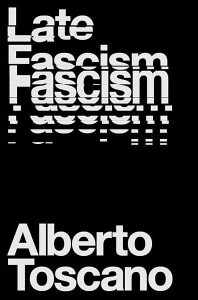 In Late Fascism: Race, Capitalism and the Politics of Crisis, Alberto Toscano unpacks the rise of contemporary far-right movements that have emerged amid capitalist crises and appropriated liberal freedoms while perpetuating systemic forms of violence. According to Dimitri Vouros, Toscano’s penetrating, theoretically grounded analysis is an essential resource for understanding and confronting the resurgence of reactionary ideologies.
In Late Fascism: Race, Capitalism and the Politics of Crisis, Alberto Toscano unpacks the rise of contemporary far-right movements that have emerged amid capitalist crises and appropriated liberal freedoms while perpetuating systemic forms of violence. According to Dimitri Vouros, Toscano’s penetrating, theoretically grounded analysis is an essential resource for understanding and confronting the resurgence of reactionary ideologies.
Late Fascism: Race, Capitalism and the Politics of Crisis. Alberto Toscano. Verso. 2023.
 Observing the leftwing populism that emerged after the 2007 financial crash, a perceptive critical theorist may have predicted that this hope-inspiring movement would quickly be reintegrated into the neoliberal order. They might further have predicted that a counter-revolution would arise in the vacuum left by the failed leftist movement and as a reaction to continuing economic difficulties. Indeed, in the last decade the rise of the populist right has been both steady and near universal.
Observing the leftwing populism that emerged after the 2007 financial crash, a perceptive critical theorist may have predicted that this hope-inspiring movement would quickly be reintegrated into the neoliberal order. They might further have predicted that a counter-revolution would arise in the vacuum left by the failed leftist movement and as a reaction to continuing economic difficulties. Indeed, in the last decade the rise of the populist right has been both steady and near universal.
[Toscano] sets out to explain why the spectre of the extreme right is not merely haunting us, but gaining political purchase across the globe
In Late Fascism, Alberto Toscano, who has been instrumental in the resurgence of Marxist and materialist sociocultural analysis over the past twenty years, offers an important theory of fascism for our current historical juncture. He sets out to explain why the spectre of the extreme right is not merely haunting us, but gaining political purchase across the globe. The measured, lapidary style of Toscano’s argument, which draws on the 20th century’s “rich archives” of antifascist thought (155), most of it Marxist or marxisant, treats the deep, structural aspects of the political often ignored by other analyses. He does this by leaning on a style of literary-philosophical excavation and elucidation more often found in classical critical theory like that of Theodor Adorno and Walter Benjamin.
One of the marks of fascism is to amalgamate seemingly incompatible positions. Indeed, it is a complex phenomenon, “scavenging the ideological terrain for usable materials”, including many currents on the left (155). Toscano does not follow mainstream political theory in conflating fascism with totalitarianism, command economies, and brute force. He argues that late fascism is “disanalogous” with historical fascisms. Instead, he focuses on the implicit forms of violence and repression – colonial, racial, sexual, and gender-based – that inform late fascism. This kind of hidden violence becomes especially noticeable, and acute, when capitalism faces financial and other crises.
As well as developing the idea that reactionary ideologies emerge out of capitalist crisis, notably as the co-option of working-class movements by the right as soon as the opportunity arises, Toscano notes the role capitalist exchange relations play in the epistemological foundation of fascist-adjacent ideologies. Yet the most original thesis in the book is that the touted freedoms of liberalism and free-market capitalism are also appropriated by late fascism. In fact, late fascism is only nominally attached to liberal ideals such as “individual action” and “free speech”. Its claim to be on the side of the individual and their political agency is clearly false, its objective really being to reproduce prior forms of subjection and create new forms of subjugation. Jessica Whyte has also suggested a similar dissimulation in the neoliberal support for human rights.
The rapid rise of this ideology may also be tied to online culture, although Toscano avoids elaborating on the political ramifications of this development. Instead, he gives a historical outline of classical Marxist arguments against reactionary thought and movements. As the subtitle of his book indicates, understanding the ideology of the far right must include a theory of the systemic reproduction of colonialism, racism and sexism. Toscano writes, “Whoever is not willing to talk about anti-capitalism should also keep quiet about anti-fascism” (158). Yet understanding fascism as a tendency within capitalism that merely continues what critical theory calls “identity thinking” is part of a critical venture “inseparable from the collective forging of ways of living that can undo lethal romances of identity, hierarchy and domination that capitalist crisis throws up with grim regularity” (158).
Understanding the ideology of the far right must include a theory of the systemic reproduction of colonialism, racism and sexism
Four key ideas explain late fascism. Firstly, it “cannot be understood without the “fascisms before fascism” that accompanied the imperialist consolidation of a capitalist world-system”, namely, the political and economic domination of the world by Europe, peaking in the 18th and 19th centuries, made possible by the material exploitation of its various colonial strongholds. Secondly, it can only be understood “across axes of race, gender and sexuality”. Thirdly, it includes the “desire for ethnonational rebirth or revanche stoked by the imminence of a threat projected as civilizational, demographic and existential”. Lastly, it involves “the production of identifications and subjectivities, desires and forms of life, which do not simply demand obedience to despotic power but draw on a sui generis idea of freedom” (156-57). These four aspects of late fascism are developed in some detail with a breadth that will satisfy anyone interested in the history of antifascist thought and resistance.
Each chapter provides a different window onto the ideology of fascism and explains why understanding it is imperative. The first chapter looks at the temporally destabilising aspects of fascist ideology, with its archaisms, anachronisms, and wrong-headed projections of majestic, uncorrupted futures. The second focuses on the dynamics of capitalism and race, mainly how the Black liberation struggles of the 1960s provide a template for understanding the racial nature of capitalism, with its continuing repression of minorities and punitive carceral system. The third chapter provides an overview of how the populist right appropriates the classical liberal understanding of individual freedom and toleration for its own purposes. It inverts such individualism, supporting the dominant narrative of equality; namely, the freedom to accumulate property and social power (the latter being skewed along racial and sexual lines, ie, white, male or heteronormative).
The fourth chapter, the most difficult, looks at the political subterfuge manifested by the “real abstractions” within a totalised exchange society. The references to Alfred Sohn-Rethel and Henri Lefevbre are especially illuminating. These latter two authors argue that capitalist ideology views everyday social relations upside down, as first pointed out by Marx in his theory of commodity fetishism and alienation. The central point is that the ends of capital and profit are prioritised over labour, the labourer being merely a commodity on the market, and ensuring capital accumulation.
Toscano demonstrates how the ‘scavenger ideology’ of fascism, which draws on Romanticism, political decisionism, a fascination with technology, and even socialism, is a pressing danger.
The fifth chapter deals again with temporality but this time through the philosophical understanding of “repetition”. Toscano singles out and censures Martin Heiddeger’s fundamental ontology”, which is concerned with “being” and the naturalised historical subject, as leading to a reactionary, “counter-revolutionary” politics. Toscano demonstrates how the “scavenger ideology” of fascism, which draws on Romanticism, political decisionism, a fascination with technology, and even socialism, is a pressing danger. This danger is magnified by its ability “to weaponise a kind of structured incoherence in its political and temporal imaginaries, modulating them to enlist and energise different class fractions, thereby capturing, diverting and corrupting popular aspirations” (110).
Based on a reading of the writings of the Italian Germanist and mythologist Furio Jesi, the sixth chapter deals with the far right’s version of the philosophy of religio mortis, a fascination with myth, sacrifice, and death, but updated for a technological (and now digital) era. Drawing on the idea of a “micropolitical antifascist struggle”, as found in the works of Gilles Deleuze, Felix Guattari, and Michel Foucault, the last chapter deals with the ambivalent erotics of fascist ideology, arguing that the libidinal introjection of violence reinforces various forms of social power. Here, Toscano also draws on the feminism of Maria Antonietta Macciocchi, claiming that the Nazi “antipolitical politicization of women” (148) resonates with current modalities of “fascist feminism” that seek “to violently secure and affirm a normative, if not necessarily heteropatriarchal, figure of woman, and which invests desire and libido in its narratives about the imminent threat of the erasure of women and even feminism by ‘gender ideology’ and ‘transness’” (150).
Toscano’s archaeology of 20th-century antifascist theory is an essential springboard for understanding the current political moment. It is a boon for those thinkers and activists interested in human emancipation and the struggle for real, rather than merely abstract, freedom. It alerts them to the threat posed to such projects by that deeply prejudicial ideology that arises alongside capitalism in crisis – late fascism.
- This review first appeared at LSE Review of Books.
- Image credit: Alexandros Michailidis on Shutterstock.
- Please read our comments policy before commenting.
- Note: This article gives the views of the reviewer, and not the position of USAPP – American Politics and Policy, nor of the London School of Economics.
- Shortened URL for this post: https://wp.me/p3I2YF-dC4






